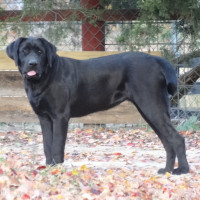Appearance of the Mastador
|
| This combination of breeds produces fairly large dogs, generally between 38.5 and 72.5 kilos, with long legs and an athletic build. They have broad heads, although narrower than the Mastiff's, and although the Mastiff's exceptionally short muzzle is sometimes passed on, the Labrador's square, medium-length muzzle is more frequently seen. The Mastador can have wrinkles around its muzzle, its almond-shaped eyes can range from dark brown almost black to hazel, and its triangular ears have rounded tips and hang close to the sides of its head, framing its face. The coat of this crossbreed is double-layered, consisting of a dense, water-resistant undercoat that is covered by a short, relatively coarse layer of straight fur that lies close to the skin, although Labrador Retriever heritage can sometimes contribute a slight wave in the coat. Mastadors generally come in solid colors, with various shades of black, brown and gold, and they often have black or white markings on their feet and chest. Black masks are also commonly passed on to the Mastador by the Mastiff. |
Temperament of the Mastador
|
| This crossbreed is generally friendly and social, although they can be more reserved than outgoing, and certain protective instincts are likely to be passed down through the Mastiff breed. The Mastador is a very large and powerful dog that can be a little exuberant, especially during its long adolescence, and any interaction between children and these dogs must be closely supervised to avoid muscle and joint strain on the dog's part or bumps and bruises on the child's. These large-to-giant dogs are generally friendly and gentle towards strangers and other animals, but proper socialization and early training will help to fully cement these tendencies and prevent any shyness, fear or aggression from taking root. This dog should be very trainable in most cases, especially if training is started early in life, however, stubbornness can be a problem and patience will be required. |
Needs and activities of the Mastador
|
| The Labrador Retriever is an active, athletic breed of dog that requires plenty of exercise every day. Fortunately for owners of Mastador hybrids, the Mastiff is a much more placid dog and doesn't require as much activity as the Labrador Retriever. In most cases, this particular crossbreed is content with an hour or two of vigorous activity. Labrador Retrievers and Mastiffs are both known for their noisy behavior when young, and although the Mastiff usually outgrows this stage, some Labradors continue to be feisty throughout their lives. It's important to remember that too much activity and activities that involve jumping can cause stress and damage the joints of very large, giant-sized dogs like the Mastador. Even if the dog doesn't appear tired, walks should be frequent but relatively short. Care should be taken to reduce the strain on growing bones and joints at every opportunity, so a nice long walk without impact will please the Mastador. This dog needs a lot of space, and although some mature candidates can adapt to apartment living, most are too active and are better suited to a larger space with a yard. |
Maintenance of the Mastador
|
| Mastadors don't have extensive grooming needs; their coats are generally short and stiff, making them adept at removing dirt and water, so in ideal conditions they should only need bathing a few times a year. This dog, being very athletic and water-loving, can have a build-up of yeast or bacteria in the ear if left unchecked. Cleaning and drying the ear at least twice a week is recommended, and even more often if your Mastador is a daily swimmer. Due to his very active nature, observation of his gait and examination of the condition of his foot pads should be included in the grooming routine. Weekly brushing will help distribute the dog's natural healthy oils throughout the coat, as well as removing loose fur. |









 English (United Kingdom)
English (United Kingdom)